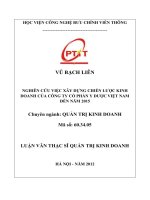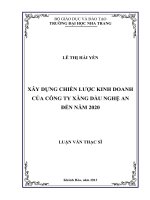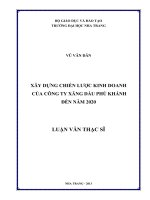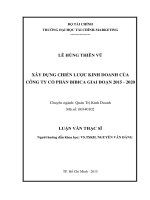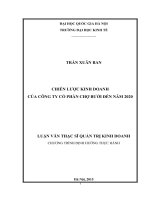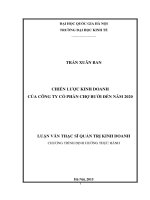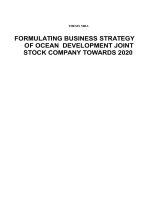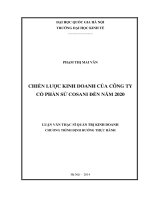Xây dựng chiến lược lược kinh doanh của công ty cổ phần đại dương đến năm 2020
Bạn đang xem bản rút gọn của tài liệu. Xem và tải ngay bản đầy đủ của tài liệu tại đây (2.28 MB, 128 trang )
THESIS MBA
FORMULATING BUSINESS STRATEGY
OF OCEAN DEVELOPMENT JOINT
STOCK COMPANY TOWARDS 2020
ACKNOWLEDGEMENTS
This research is conducted by Group No.12 - M04 Class - Global Advanced
Master of Business Administration Program - Griggs University. We commit that
this is our study, and that study results are accurate and unavailable in any other
studies.
During the study, we have received valuable support from many individuals,
organizations, agencies and enterprises.
We wish to thank leaders, managers and employees of Ocean Development Joint
Stock Company for releasing the burden of data provision, cooperation, exchange
and discussion.
We extend our special thanks and appreciation to many individuals and experts
who have shared with me an opinion and response to questionnaires of the Group.
We would like to express our deepest thanks to lecturers, Board of Management,
and managerial staffs under Global Advanced Master of Business Administration
Program - Griggs University in Hanoi for communicating knowledge, creating
favorable conditions in all fields for us to accomplish this project.
Last but not least, we would like to express our deepest thanks to all students of
M04 class- Global Advanced Master of Business Administration Program -Griggs
University for sharing information, material support and invaluable support to
accomplish this project.
The authors:
1. Tran Thi Kim Oanh
2. Pham Duc Trung
3. Nguyen Van Binh
4. Luyen Xuan Trang
i
LIST OF ABBREVIATIONS
AS:
Attractive score
DaiAn:
Dai An Joint Stock Company
EFE Matrix: External Factor Evaluation Matrix
GDP:
Gross Domestic Product
GSO:
General Statistics Office
HUD:
Housing and Urban Development Corporation
IFE Matrix: Internal Factor Evaluation Matrix
Namcuong: Namcuong Group Joint Stock Company
Ocean JSC: OCEAN Development Joint Stock Company
PMU:
Project Management Unit
QSPM:
Quantitative Strategic Planning Matrix
Songda:
Song Da Corporation
SWOT:
Strengths-Weaknesses-Opportunities-Threats
TAS:
Total attractive score
Vinaconex: Vietnam Construction and Import-Export Joint Stock Corporation
VND:
Vietnam Dong
ii
TABLE OF CONTENTS
Page
1
INTRODUCTION
Chapter 1
SOME THEORETIC BASES FOR BUSINESS STRATEGY
FORMULATION
1.1. Overview on business strategy
1.2. Defining strategic targets and tasks
1.3. External business environment
1.4. Internal analysis
1.5. Selection of business strategy
Chapter 2
3
8
10
16
20
BUSINESS ENVIRONMENT OF OCEAN DEVELOPMENT JOINT
STOCK COMPANY
2.1. Introduction to Ocean Development Joint Stock Company
2.2. External environment of Ocean Development Joint Stock Company
2.3. Internal environment of Ocean Development Joint Stock Company
CHAPTER 3
26
28
48
FORMULATING BUSINESS STRATEGY OF OCEAN
DEVELOPMENT JOINT STOCK COMPANY TOWARDS 2020
3.1. Strategic Task to 2015
3.2. Formulating business strategy to 2015 for OCEAN JSC
3.3. Determination and implementation of OCEAN JSC’s strategy to 2015
3.4. Implementation solutions of business strategy
Conclusions and recommendations for further research
67
69
79
80
84
References
86
Appendices
88
iii
LIST OF TABLES AND FIGURES
Chapter 1
Figure 1.1: Missions of business strategy management
Figure 1.2: Basic model of business strategy planning
Figure 1.3: Strategy planning process
Figure 1.4: Michael Porter's five competitive force model
Figure 1.5. Examples of External Factor Evaluation Matrix (EFE)
Figure 1.6: Examples of Internal Factor Evaluation Matrix (IFE)
Figure 1.7: SWOT matrix model
Figure 1.8: Example of Quantitative Strategic Planning Matrix (QSPM)
Chapter 2
Table 2.1: Key macroeconomic data of Vietnam in 2004-2008.
Table 2.2: Some indicators on Vietnam Real Estate Market
Table 2.3: Monthly average income per capita in 2006
Table 2.4: Development trends of Vietnam Real Estate Market
Table 2.5. External Factor Evaluation (EFE) Matrix
Table 2.6. Human resources of OCEAN JSC
Table 2.7. Some indicators of asset and financial scale of OCEAN JSC
Table 2.8: Some financial indicators of OCEAN JSC
Table 2.9: Competence self- assessment of OCEAN JSC
Table 2.10: Internal Factor Evaluation (IFE) Matrix
Chapter 3
Table 3.1. SWOT Matrix of OCEAN JSC
Table 3.2. Primary selection of master strategy
Table 3.3. Quantitative Strategic Planning Matrix – QSPM (1)
Table 3.4. Quantitative Strategic Planning Matrix – QSPM (2)
Chart 3.1 Strategy implementation schedule
iv
Page
6
7
8
12
15
19
21
22
31
34
40
43
48
49
50
58
61
66
70
76
77
78
79
INTRODUCTION
1. General context, necessity and significance of the study:
Enterprises are making a significant contribution to economic growth and
market economy reform in Vietnam. However, it is shown that most of
Vietnamese enterprises, especially private sector, are characterized by low
competitiveness, a series of constraints and inadequateness in management
including business strategy management.
Being a private enterprise, incorporated in 2006, Ocean Development Joint
Stock Company operates in a dynamic, demanding and risky market i.e.
Vietnam real estate market. Although some achievements and growth in
revenue and profit, the Company’s business operations are recently unstable,
modest and unclearly-oriented due to various reasons in which the confusion
when positioning market, limited competence and failure to develop a
comprehensive business strategy to act as a background for specific business
administration activities. Therefore, investigation and application of the
modern business administration concepts for Business Strategy Formulation
are urgent and practical significance to Ocean Development Joint Stock
Company.
In such context, Group No. 12- M04 Class - Global Advanced Master of
Business Administration Program of Griggs University in Hanoi selects the
topic “Formulating the Business Strategy for Ocean Development Joint
Stock Company towards 2015” to fulfill the assignment of Strategy
management module.
2. Aims and objectives of the research:
This assignment aims at applying knowledge accumulated from Global
Advanced Master of Business Administration Program (Griggs University)
to formulate business strategy of Ocean Development Joint Stock Company
to 2015.
1
Development of Ocean Development Joint Stock Company is supported and
strengthened.
3. Research methodology: 2 main methodologies:
Desk study:
o To seek, collect, review and select theoretical documents applied for
the assignment.
o To seek, collect, analyze and evaluate documents and data of business
environment.
Analyst-driven approach:
o To collect opinions by questionnaire to support the business
environment assessment as well as available competence of the
Company.
o To consult directly internal and external knowledgeable experts.
4. Outline of the Study
Introduction
Chapter 1: Literature review on business strategy formulation
Chapter 2: Business environment of Ocean Development Joint Stock Company
Chapter 3: Formulating Business Strategy of Ocean Development Joint Stock
Company TOWARDS 2020
Conclusions and suggestions for further studies
2
Chapter 1
SOME THEORETIC BASES FOR BUSINESS STRATEGY
FORMULATION
•
Chapter 1 aims to investigate some fundamental theories to act as a ground
for developing business strategy of Ocean Development Joint Stock Company.
•
Before investigating theories on business strategy, it is required to specify
some issues relating to real estate market- where Ocean Development Joint
Stock Company is operating. Real estate market is a combination of market
segments. Each segment has various products: Products classified as per utility
of property include land, commercial works, service, industrial works, tenement
building, and special works. Products classified as per market operation form
include property for sales, purchase, transfer; property for mortgage, insurance,
deposit; real estate transaction service; joint- name real estate, equitization,
equity, etc. Products classified as per region include urban property, rural
property, and urbanization property. Products classifieds as per market
admission include primary property (for instance coarse building directly sold
by the Project Owner) and secondary property (turn key complete building), etc.
[23]
•
Major business lines of Ocean Development JSC are: To invest in
commercial real estate development (Commercial Center, head market,
retailers). This is a combination of activities including: 1) Input: project design,
land receipt, etc.; 2) Manufacturing and transfer: works construction; and 3)
Output: Post-investment management and business. Therefore, it is possible to
study theoretical model on Business Strategy Formulation for manufacturers to
apply for Ocean Development Joint Stock Company.
1.1. OVERVIEW ON BUSINESS STRATEGY
1.1.1. Some concepts and characteristics of business strategy
3
In different phases, contexts and approaches, theoretical research models present
various concepts on business strategy. Generally, there are 3 approaches covered
with “business strategy” concept [16]:
The first approach considers the business strategy as a management norm, in
which, the business strategy is only a form of business plan by nature.
G.Arlleret revealed that strategy is the determination of how and what designed
to achieve the particular goals via policies. Sharing this perspective, D.Bizrell
specified strategy as a master plan to direct or orient enterprises to the desired
goals; acting as a background for planning policies and operation techniques.
Gluecl defined that business strategy is a consistent, comprehensive and
synthetic plan designed to achieve corporate goals.
The second approach considers business strategy as an art to compete in
market and develop enterprise. Alain Threlart said that strategy is an art
enterprise applies to protect against competition and win. M. Porter also defined
that: Strategy is an art of constructing reliable competitive advantages for
preventative purposes.
The third approach- a combination of the two aforesaid approachesconsiders business strategy as an art of consolidating and controlling operations
to obtain long- term goals of enterprise. Right in 1962, Alfred Chandler
specified that: Business strategy includes determination of corporate long- term
goals and objectives and application of a series of necessary resource allocation,
to achieve these goals. Later, Mintzberg introduced a general model and
completely reflected various concepts on business strategy with 5’s P
definitions of strategy namely Plan, Pattern, Position, Perspective, and Ploy
[10].
Regardless of how to access to, nature of the strategy is generally characterized by
following straits [16]:
The strategy explicitly defines basic goals and business orientation of
companies in each period.
4
The strategy is oriented to the corporate continuous and reliable development
in an often-fluctuating market.
The strategy is used to effectively combine development and exploitation of
corporate resources in the present and in future; uphold advantages and take
opportunities to gain competitive advantages.
The strategy is reflected in a continuous process;
The strategy is oriented to attack and win in market.
The strategy is often constructed in a long period (3 years, 5 years, 10 years
and so forth).
Within the scope of this study, business strategy is interpreted as the art to design
and organize facilities to achieve long- term goals of companies associated with
fluctuation of business environment.
1.1.2. Business strategy in the corporate strategy system
Various strategy levels are available in the enterprises, including:
Corporate strategy refers to the overall goals and scale of corporate to satisfy
expectations of the owner. This significant level orients process of making
strategic decisions in the entire enterprise. Corporate strategy is explicitly
presented in “mission statement”.
Business strategy refers to how companies can compete successfully in a
particular market. It involves in strategic decisions on product selection, meeting
the Buyer demand and gaining the competitive advantage against others rival to
exploit and generate new opportunities.
Operation strategy refers to how each division in the enterprise will be
organized to perform the strategic orientation at company level and every
division in the company (for example marketing strategy; financial strategy;
human resources development strategy, etc.)[5]
1.1.3. Significance of business strategy formulation in the strategic
management
5
•
Strategic management is a system of decisions and actions to
determine long- term performance of a company. Strategic management
includes the continuous activities namely review of internal and external
environment; strategic formulation; strategy performance and strategy control
assessment. Therefore, the strategy study emphasizes external opportunity and
thread supervision and evaluation in the context of internal strength and
weakness [10].
•
Strategic management has 5 interrelated tasks including developing
strategic vision and mission; setting up goals; development strategies to achieve
goals; strategy
performance; performance
evaluation, supervision
and
adjustment [10] (refer to Figure 1-1). Therefore, Business Strategy Formulation
is one of tasks of business strategic management in the company.
Figure 1-1: Tasks of business strategic management
1. Develop
strategic
prospects
& missions
Repair
where
necessary
2. Setting
up goals
Repair
where
necessar
y
3. Developing
strategies to
achieve goals
4. Perform
selected
strategy
5. Performance
assessment,
supervision &
adjustment
Reform and
modify
where
necessary
Reform and
modify
where
necessary
Restore
1,2,3,4
where
necessary
Source: Le The Gioi, Nguyen Thanh Liem, Tran Huu Hai (2009)
1.1.4. Business Strategy Formulation
In spite of various concepts on business strategy, the basic method to plan the
business strategy was to have consistence and less change in nearly 60 years ago;
including selection of key missions and vision of the company; internal
environment analysis to identify strength and weakness of the company; selection
of strategies by seeking for resources, capacity and core competence and developing
6
it to mitigate risks, make use of opportunities from external environment; and
strategy performance.
7
Figure 1.2: Basic model of business strategy planning
Mission and objectives
External analysis
(opportunities and
threats)
Development and
selection of strategies
Internal analysis
(seeking for
resources, capacity
and core competence)
Functional strategy
Business strategy
Global strategy
Corporate strategy
Organization
structure
Harmonizing strategy,
structure and control
Control design
Strategy modification
Source: Le The Gioi, Nguyen Thanh Liem, Tran Huu Hai (2009)
Basic model of business strategy planning as illustrated in Fig. 1.2 can be simplified
into seven step works of “Planning the business strategy” as in Figure 1-3.
8
Figure 1-3: Strategy planning process
Strategic functions, tasks and objectives of
the company (1)
Analysis of
business
environment (3)
Corporate internal
analysis
(2)
Strategy selection (4)
Corporate strategy (5)
Partial business strategy
Strategy implementation
(6)
Performance inspection
and assessment (7)
Feedback
Source: Ngo Kim Thanh, 2009
Within the scope of the study, Business Strategy Formulation covers internal and
external environment analysis and strategy selection with impact of corporate
vision and mission.
1.2. DEFINING STRATEGIC TARGETS AND TASKS
1.2.1. Identification of the relevant parties
The enterprise should adopt a strategic plan, demonstrated by the clear targets. The
parties, whose interests are affixed to the business (called the relevant parties), shall
influence these targets. They are individuals or groups of individuals, affecting to
9
the strategy and shall be subject to the influence of the strategy implementation.
Therefore, when determining the vision and the mission of the enterprise, it is
important that the most relevant parties be identified and set the priority for the
strategies that can satisfy their demands. Normally, there are the relevant parties in
the enterprise (the owners, the managers, the staff, the leaders etc directly affecting
and participating in the strategy formation process, at the same time, being impacted
by the strategy under the implementation in the future) and the relevant parties
outside the business (for example, the client, the supplier, the Government, the trade
union, the local community, the public etc). These subjects may not participate in
the strategy formation but have a major impact on the content of the business
strategy, especially, the Buyer [16].
1.2.2. Determination of vision and mission
The vision shows the highest and most general purposes, desires of the
enterprise; expressing the aspiration about what the enterprise wishes to reach.
The vision needs to be impressive enough so that all persons in the business try
their best to attain their ideology. The structure of the vision shall comprise two
inseparable aspects, which 1) are the core ideology (determination of the
permanent characteristics of the business; supply of the adhesive substances of
the entire business; including the core value means the system of principles and
the guiding principle; the core purpose or the most fundamental reasons leading
the existence of the business, 2) envisioned future including the challenging
targets and the attractive, convincing description on what the challenging targets
wish to be achieved [16].
The mission statement is a key command on how the business realizes
their requirements of the relevant parties and forms a basis for cater for the
vision. However, the mission must be somewhat that can be obtained within a
period of time. The statement of mission shall form the basis for the whole
strategy planning; first of all, it must express the strategy intention, which means
the general ambitious targets to challenge the business [16].
10
1.2.3. Determination of the strategic tasks
Defining the strategic tasks is to answer the question that is what are the business
activities of the business? To answer this question, there area various ways,
however, the model used by many enterprises belongs to Derek F. Abell. Thereby,
we should determine the business activities on three aspects. First, who shall be
satisfied (for which group of Buyer?); secondly, what they shall be satisfied (what
do the Buyers need?), thirdly, the way for which the Buyers shall be satisfied (by
the skills or any other extraordinary capabilities?) [16].
1.2.4. Business target
The business targets shall have the following characteristics: accurate, and can be
measured, must target at the key, challenging issues but can be achieved (actual),
determined to with a length of time and can supply the tools to measure the
performance of the manager. In the theories about management of the strategy,
people also can differentiate the long-term and short-term targets.
1.3. EXTERNAL BUSINESS ENVIRONMENT
The environment of the enterprises can be divided into two degrees namely the
macro environment (or called the general environment) and the microenvironment
(or called the industry environment). Another point of view in the business
environment (with the meaning that taking the business as the subject of research),
the business environment can be viewed under two angles including the external
environment (consisting of the macro, microenvironment) and the internal
environment of the enterprise. However, the business environment is the general
motion, which interacts with each other among the elements and internal and
external forces of the system but shall be directly or indirectly affect to the business
and production result of the business. The purpose of the business environmental
analysis is to help the enterprises answer the question: which are the elements and
the degree of influence on the business results? Therefore, two views on the
business environment mentioned do not contradict with each other and can
replenish with each other.
11
1.3.1 Macro environment
The analysis of the macro environment for the business shall identify the
opportunities and threaten to exert the influence on the operations of the business in
the future; that can comprise [10]:
The economic environment: The environment refers to the development of
the economy, the supply of capital, the growth of Gross Domestic Products; the
rate of inflation, the rate of interest, the financial policies, the developments of
types of market, the economic institution and so forth. These are the elements
affecting dramatically to the operation and business strategy of the business.
The technological scientific environment refers to the analysis of the
technological scientific environment for business identification and exploitation
of the appropriate technologies to create the competitive advantages for the
business on the market.
The political- law environment refers to any business wishes to exist and
develop shall have to operate in accordance with the political- law
environmental condition of the local country. The enterprises that can operate is
accepted by the society, to the extent that the society find that any of condition is
hardly accepted, it shall withdraw these allowed conditions by requiring the
Government to intervene through the policies and the system of law. The
political and law elements of the local country can create the opportunities or
risks for the business.
The cultural, social environment: It is the change of the lifetime point of
view, the standard of living, the spending habit, the population growth rate, the
cultural standard, the social perception, the psychology, the living perception
etc. These changes can have a profound influence on the business production
activities of the business.
The natural environment such as forest, air, water resources, natural
resources, weather, the climate, land, geology and so forth are the natural
12
elements very sensitive for any business, affecting the business decisions of the
business and can cause the influences on both Buyers and business etc.
1.3.2. The industry environment
The industry environment is the external relationship of enterprise but has the direct
impact on the production and business activities as well as the existence and the
development of the enterprises. There are many theoretic models supporting the
industry environmental analysis, however, at present, the model “five competitive
models” of Michael Porter has many predominant advantages in helping the
strategic managers to realize the strengths and weaknesses so that they can issue the
appropriate policies to take advantage of the opportunities and avoid the risk caused
by the industry environment.
Figure 1-4: Michael Porter Five Forces Model
Potential
Entrants
Threat of new Entrants
Bargaining Power
of Suppliers
Supplier
s
Industry
Competitors
Rivalry among
existing firms
Threat of Substitute
Products or Service
Buyers
Bargaining Power of
Buyers
Substitutes
Source: Ngo Kim Thanh (2009)
According to Michael Porter, the industry environment of the business shall consist
of five basic elements [10, 11]:
1) Buyers buying the products and services of the enterprise; 2) the suppliers
supplying the input for the business and production of the enterprise; 3) the rivalry
in the existing firms; 4) the potential competitors; and 5) substitute products. They
13
are five forces, frequently laying the bargaining power on the enterprise. The
enterprise gains the success when they control the correlation of forces among the
enterprise and those forces.
(1) Buyers: Buyers are those, who buy the corporate products, therefore, they have
considerable role for the survival of the company; bringing the market, the revenue,
the orientation of the corporate business, even can consider as a part of the business.
However, Buyers also create the pressure causing the difficulty and reduce the
corporate profit.
There is one group of Buyer or are two groups of Buyers but there are many
sellers creating the monopoly. This is the disadvantageous situation of the
business because the power entirely belongs to the Buyer.
Buyers can buy a great amount of goods from the business. When they place
a big number of orders, they can cause the pressure in negotiating the price
for the business.
The high rate of standard of products. Because the product is relatively even,
so, Buyers can easily select another supplier, at the same time, will spend
less cost on this conversion, thereby, it shall boost the position of the Buyers.
Buyers may not be really selective for the quality of goods that they buy,
thus, they shall not be ready to pay higher cost, although, the products can be
considered as having higher quality. Therefore, it is necessary to give the
advertising measures, seminars, discussions, presentation on the products in
the course of providing the training courses on the updated information on
the domestic and international quality for Buyers.
(2) Suppliers area the individuals or enterprises that can satisfy the inputs for the
enterprises such as raw material, equipment, manpower, capital, services, land, the
site for production and business etc. It is similar to the Buyer analysis. The only
difference is that the position of the enterprise is Buyer. Enterprise should exploit
radically the advantages of Buyers as analyzed as above. The suppliers can cause
14
the strong pressure on the operations of the business, especially, when they are the
exclusive suppliers.
(3) Competitive competitors: competitive competitors are often the major threats
to the corporate development, especially in the saturated market period and now
when the market has impediments hindering the withdrawing from the market of the
enterprises in the sector. Therefore, it is very important for enterprises to give
analysis on the competitive competitors.
The companies should know their
competitive competitors, the competitive strength as well as the growth rate of
business sector, the density of fixed capital of the competitive competitors, the
targets and business strategies as well as the strategic policies used by them and
how they change their strategy, the financial results and market position as well as
their financial potential. It is supposed to choose some of the most important
competitors, then compare with their competitiveness in accordance with the
product samples, the supply capacity, the arts and technique for serving the Buyers,
the warranty, the density of contribution, the product prices, advertising, assistance,
the professional standard of the salesman, the quality of products, the developing
potentiality, the flexibility, the revenue, the market share, etc. When making
assessment, it is noted that the poorer aspects still create the various business
strategies and shall not be included into the weaknesses of the enterprises.
(4) Potential competitors are the new entrants taking part in business in any sector
or intending to penetrate the market, however, they may not indirectly threaten to
the business interests of the companies but can become a competitor that
compromise the interests of business in the future. To cope with the potential
competitors, the present enterprises often put the barriers against their being
penetrated from the outside forces such as forming the advantage of economy of
scale, increasing the goods purchasing conversion expenses of Buyers by
specializing their products, consolidating their advantageous supply source etc.. In
the necessary case, the existing companies can enter into a close liaison to prevent
the new risk of penetration from the outside forces.
15
(5) Substitute products: substitute products are those of other market but can meet
the market demand like the main products. The existence of substitute products
shall limit the potentiality of increasing the business profit. If the price of main
products increases, it shall engender a hike in the demand of substitute products.
Substitute products are usually the results of the technological explosion. To avoid
being lagged far behind in the market, apart from the analysis of the relationships in
price of substitute products, in the business strategy, the enterprises should pay
attention to the due investment of their existing resources for the research and
application of new technology aimed at forming the products, which have the high
competitiveness in the market.
1.3.3. External Factor Evaluation (EFE)
The influence of the external factor to the enterprises shall be determined through
the qualitative analysis. However, the modern business management science
demands that these be quantified in order to make the enterprises and strategic
planners have a more accurate, objective view on the influence of the chances and
challenges from the outside forces. One of the tools to realize these goals is to build
the external factor evaluation matrix (EFE). There are various forms and methods to
construct EFE matrix.
Figure 1.5 Example of the External Factor Evaluation Matrix (EFE)
Key external
factors
The first factor
The second factor
The n factor
Total
Weight
Rating
Weighted scores
------------------1.00
(100%)
-------------------
------------------ Weak
Average
Good
Source: Nguyen Thi Lien Diep (2006)
Figure 1.5 describes the way of building EFE, therefore:
• The most fundamental factors identified from the external environmental
analysis.
16
• The factors having different important levels. Those who make the matrix
must define the importance of each factor in the external influence general.
Total classification marks for all elements shall be 1.0 or 100 % if
calculating equal to %.
• The influenced factors engender the various reactions of the enterprises. EFE
must indicate that degree of reaction, for example: 1 = little reaction; 2 = the
average reaction; 3 = the above average reaction; 4 = the good reaction.
• Multiply the importance of each factor with the degree of classification to
identify the marks in the importance. Add the total marks in the importance
for each variable to identify the total mark of the business. For example, with
such way of classification as the example, the mark that the business can
receive is the highest is 4.0, the average is 2.5, and the lowest is 1.0. These
marks bear the significance of assessing the relevance of the current strategy
being applied for risks and environmental risk [5]
1.4 THE INTERNAL ANALYSIS
The internal analysis is to trace the points and internal weaknesses of the business in
order to exploit the strength and improve the weaknesses, aiming at the strategic
goals of the enterprises. The internal analysis of the business can help analyze the
basic function of the business that is production, finance and marketing [8].
1.4.1. The internal issues that need to be analyzed
- Analysis of the production process:
The production process shall be the principal activities of the enterprise affixed to
the formation of the products and services. It decides upon the success of the
enterprises and other fields, the high quality products and services and reasonable
cost shall facilitate for the marketing and financial activities. The production
process also exerts the great reciprocal influence and shall form the premise for the
business management, development research and the information system. When
analyzing the business production process, it is important to first evaluate whether
the equipment and the manufacturing technology that can create the output meeting
17
the market or not? If it is otherwise, how will be the correction measures? The
large-scale production, stable input supply with reasonable price, the suitable
arrangement of production facilities, the warehouse, and the yards shall generate the
high efficiency for the production process. Besides, it is also important to take into
account of the labor use, the satellite units, and the inspection of the enterprises [8].
- Financial analysis:
The financial resources (such as cash, the credit loan ability, owned capital, etc) are
the most basic sources because they are the premise for other resources and form
the final results of the activity sequence (or a process) of production and business of
the business.
The financial analysis shall be base on the economic, financial standards such as the
profitability per capital, the mobile capital, the capital recovery ability, the cash
flow, the debt coefficient, the short-term and long-term capital mobilization ability,
the company capital sources, the capital expenses as compared to the entire sector
and the competitors, the tax issues, the relationship with the owner etc… Assessing
the financial potentiality of the business shall be the best mean to take into account
of the competitive position of the business and shall be the condition to attract the
external capital. This is the basic condition to make the competitive strategy more
feasible, through analyzing the financial indicators, the strengths and weaknesses of
the business in the investment, finance, and dividend [9].
- Analysis of the organization, management and administration activities:
•
This analysis shall focus on the issues such as how the business has executed
the management activities related to the preparation for the strategy formation.
Whether the business organizes the monitoring and forecasting of the
tendencies related to the macro and the industry environment? Whether the
business has established the clear goals? How is the business strategy? How is
the formation process and content of operations? Whether the distribution of the
resources base on the set out goals? How are the strategies and supporting
policies? Whether the enterprises give any plan to cope with the contingencies?
18
Whether it is clear like in the organizing diagram or not? Whether the
organizing diagram shows the agreed principles? How is the command?
Whether the manager organizes the authorization effectively or not? How are
the works groups organized? [8]
•
Regarding the human resources management, it is important to refer to the
participation of employees in the management, the working attitude, the
satisfaction in the work, the encouragement of the creativity in the works, the
two-way communications and exchange in the company, the number of
structures and role of the unofficial Buyer group, the capability of the
employees. [17]
•
Concerning the supervision and the analysis shall help answer the questions
such as how the enterprises have the financial control system, the sales, the
production, the targets, and the inventories. Whether it has the efficient control
system? How is the quality control? How is the information system? Is it likely
to work out the business control system as soon possible? [8]
- Marketing operation:
First of all, it is important to give analysis on the Buyer structure, the consumption
channels with the scope of quantities and control degree, the flexibility in the
evaluation, product samples, advertising and assisting tools for consumption policy,
then, to compare the development of each consumption channel, to set out the
necessary instructions for the marketing strategy formation.
It is also important to pay attention to the potentiality for product consumption, the
revenue structure, the profit rate from the revenue, the quality diversification level
and the popularity of the products and services, the business market share, the trust
of Buyers, the efficiency of the promotion and advertising campaigns, the post sale
services and Buyer caring services.
Then it is assumed to analyze whether the input supply is stable and favorable,
combine the consideration of the survival cycle of products to check the research
19
and development of new products as well as analyze the business opportunities that
can be promoted [11].
- Development and research activities:
In this aspect, it is important to consider the corporate interests and investment for
the technology, product development research activities, the conditions of the
development and research activities, the quality, the research and development
results, the research and development research capability (finance, human being,
organization, etc); the studying and developing results etc… [11]
- The information collecting and processing:
The information system is a component linking all functional activities, at the same
time; it shall provide the basis for the business management decision. Therefore, the
efficient information system shall pay contribution to improving the operations of
the business and enhance the quality for the management decisions [11].
1.4.2. Internal factor evaluation matrix
The internal analysis results of the business shall is also demonstrated by “the
Internal Factor Evaluation Matrix” (IEF). The forms and ways of building the
internal factor evaluation matrixes in the same way as EFE are as follows:
Figure 1.6: Example of the internal factor evaluation matrix (IFE)
The key internal
Weight
Rating
------------------1.00
-------------------
Weighted scores
factors
1
2
n
Total
------------------ Weak
Average
(100%)
Good
Source: Nguyen Thi Lien Diep (2006)
1.5. SELECTION OF BUSINESS STRATEGY
1.5.1. Formation of the business strategy options
20
